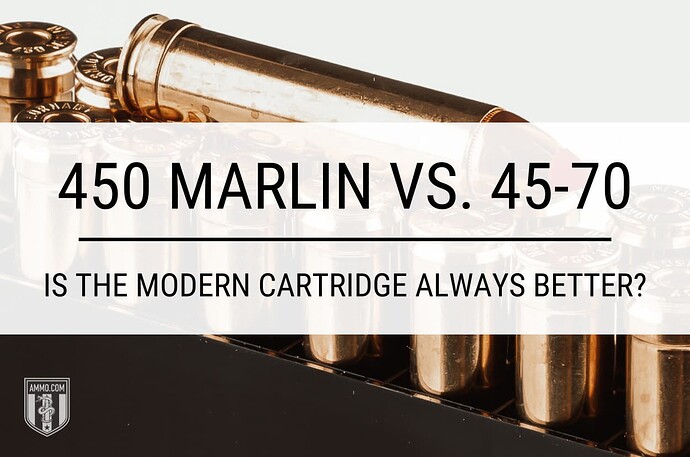Recognizing an opportunity to modernize the 45-70, Marlin teamed up with Hornady to release the 450 Marlin in 2000. The 450 Marlin was designed to mimic 45-70 ballistics, but also to handle higher pressures that would have destroyed older 45-70 rifles.
The 450 Marlin offers big game hunters a level of safety when handloading hot ammo. But the round has fallen out of favor in the shooting community, as most view it as unnecessary. This begs the question: Is it worth upgrading to a 450 Marlin, or is the stalwart 45-70 good enough?
In this article, we will evaluate the 450 Marlin vs. 45-70 debate to help you understand the differences between the two and give you a clearer idea of which cartridge is better for your shooting needs.
What is the difference between 450 Marlin and 45-70?
These rounds are similar to one another from a ballistic standpoint. The key difference between them is that the 450 Marlin features a belted case designed for modern firearms, whereas the 45-70 has a rimmed case designed for black powder (but which is also compatible with modern, smokeless propellant).
Cartridge Naming
One thing that can be confusing to newer shooters is the old naming system used for black powder cartridges, which is different from the conventional system for naming modern ammunition.
The 45-70 Govt, which was developed in 1873, was named after the old system. The cartridge’s original full name for the was .45-70-405, meaning:
- .45 - Nominal diameter of the bullet, in inches (i.e. 0.458”)
- 70 - Volume of the charge of black powder, in grains
- 405 - Weight of the bullet, in grains
Load Variations
The .45-70 was developed by the U.S. Army’s Springfield Armory for its new Model 1873 rifle, which came to be known as the “Springfield Trapdoor.”
The original Springfield load fired a 405 grain lead flat nose bullet at a muzzle velocity of nearly 1,400 feet per second (fps), with 1,748 foot-pounds (ft-lbs) of accompanying muzzle energy.
Although respectable in their own right, these numbers are unimpressive compared to modern 45-70 loads, which can easily surpass 2,200 fps and 3,400 ft-lbs. This disparity in performance stems from advancement in propellant technology. Modern smokeless propellant is far more potent than old-fashioned black powder.
Modern metallurgy and firearm design have allowed the 45-70 to become what many online shooting forum members refer to as “nuclear loads.” These are extraordinarily powerful and exceed pressures that older rifles can safely handle. Ruger No. 1 and No. 3 are two examples of modern, single-shot rifles capable of handling hot 45-70 loads.
Most custom ammo manufacturers specify which rifles their 45-70 loads are appropriate for.
However, this has not prevented some tragic accidents from happening. More than a couple Springfield Trapdoor rifles have been destroyed by modern 45-70 loads.
Such accidents were the genesis for the development of the 450 Marlin. Hornady and Marlin set out to create a round that would replicate hot 45-70 ballistics, but also be impossible to chamber in firearms that can’t accommodate its high pressure.
Continue reading 450 Marlin vs. 45-70: Is the Modern Cartridge Always Better? at Ammo.com
